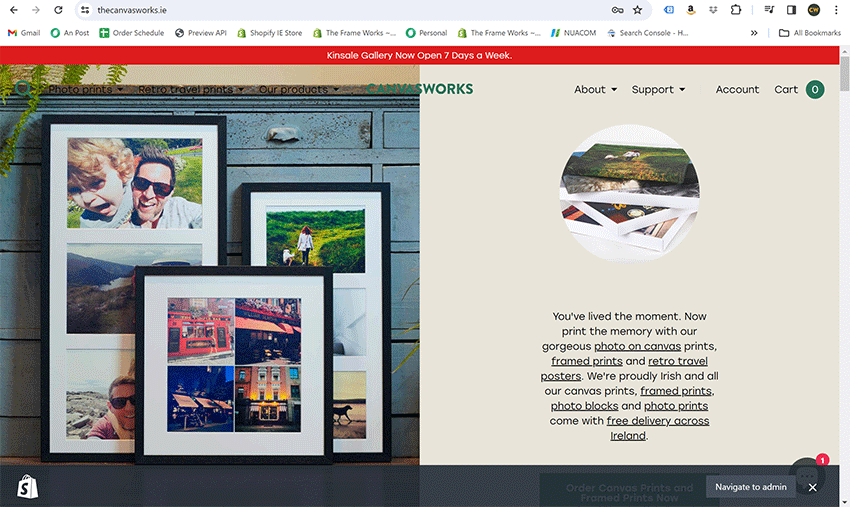The Hidden Weakness of Shopify that Merchants Should Know About

In the digital age, the necessity of a strong online presence cannot be overstated for businesses of any size. E-commerce platforms like Shopify have emerged as go-to solutions for entrepreneurs seeking to establish their digital storefronts quickly and efficiently. With its user-friendly interface and robust features, Shopify has become a popular choice for businesses looking to enter the realm of online retail. However, amidst the convenience and ease of use lies a lurking vulnerability that can haunt businesses in the long run: dependency on developer support.
In my 10 years on the Shopify platform running Ireland's most popular canvas prints website, I have first-hand, painful experience of this problem over two cycles of web development and one cycle of mobile app development. In both cycles, I have gone through exactly the same stressful, frustrating and expensive experience.
After all this time on the platform, I firmly believe there’s a little-discussed achilles heel buried deep in the heart of Shopify that every small e-commerce owner or operator needs to be aware of - especially if your build involves a custom theme. And that issue is on-going developer support and the unwillingness or inability of finding developers willing to invest the time and resources that appear to be necessary in taking on custom theme work that was done by a third party.
In this post, I’m going to outline my own experiences with building custom themes on Shopify and highlight the problems I have now had to deal with on both occasions when it came to finding on-going support for themes I spent tens of thousands of euros developing. I’m asking why Shopify takes such a hands-off approach to protecting Shopify merchants who invest in their platform and in part two, I will identify measures Shopify could and should be taking to help their merchants protect their investments in custom code bases that can overnight go from asset to liability when developers withdraw their support for sites they’ve built.
Shopify offers a plethora of customization options, allowing businesses to tailor their online stores to their specific needs and branding requirements. While this flexibility is undoubtedly advantageous, it also comes with a downside. Many businesses, particularly those lacking technical expertise, rely heavily on developers to set up and maintain their Shopify websites. While this may seem like a prudent strategy initially, it can lead to significant challenges down the road.
The central weakness of hiring developers to build a website on Shopify becomes apparent when businesses find themselves in need of ongoing support and maintenance. Unlike proprietary platforms where support and updates are readily available from the platform provider, Shopify relies heavily on third-party developers for these services. While there is a vast pool of Shopify developers available, the problem arises when businesses discover that the developer who initially built their website is no longer available or unwilling to provide support.
My first canvas prints website on Shopify was a big success and it cemented my long-term relationship with the platform. A custom theme developed by a leading UK agency, the site got great customer feedback, worked very smoothly and helped me to grow the business. The site was so professional and advanced that we quickly became synonymous with high-quality photos on canvas and framed prints in Ireland.
But very quickly after the launch, it became clear that the agency who had developed the site was growing at an almost exponential rate and was increasingly working with Shopify plus enterprise level clients with budgets that dwarfed my resources.
Quite simply and almost overnight, I was swimming out of my depth. The agency in question was very nice about it and at no point left me completely in the lurch. But at the same time, they found various ways of communicating to me that I was no longer a viable fit for their agency. It was time to move on.
In my naivety, l didn’t appreciate that I was about to collide with what I can now see is a deep-rooted weakness in the Shopify model - transitioning to third party developer support.
With the benefit of years of experience, I can now see the problem with a level of clarity that I simply didn’t have back then. This reluctance among developers to support websites they didn't build lies in the inherent complexities of custom-coded solutions. When developers create custom functionalities or integrations tailored to a specific website, it often involves intricate coding techniques and unique configurations. My theme was packed full of these custom functionalities.
As a result, supporting my website required a deep understanding of the underlying codebase and architecture, which might not be readily apparent to developers who didn't participate in the initial development process.
There are several other factors that can put third parties off taking on a site they didn’t initially build.
Take for instance, concerns about accountability and liability. When troubleshooting issues or implementing updates on a website they didn't build, developers may encounter unforeseen challenges or unintended consequences resulting from the previous developer's decisions. In such cases, the new developer may find themselves in a precarious position, held responsible for resolving issues that they had no hand in creating.
Another factor contributing to the reluctance of developers to support third-party Shopify websites is the opportunity cost involved. Developers often prioritise projects where they have full control and ownership, as it allows them to work more efficiently and effectively. Supporting existing websites, especially those built by other developers, can be time-consuming and less rewarding compared to starting fresh on a new project. Consequently, developers may be inclined to decline such opportunities in favour of more lucrative or fulfilling projects.
In my case, with my first theme, I encountered all these issues and more. It became apparent that the lack of continuity in developer support was going to hinder the scalability and evolution of my Shopify website over time.
As my online photo printing website grew and evolved, my online presence needed to adapt accordingly, incorporating new features, functionalities, and integrations to meet changing market demands. However, without consistent developer support, I found it challenging to implement these changes effectively, leading to stagnation and missed opportunities for growth.
Ultimately, I knew I needed to start from scratch all over again and that’s what I did in 2021 when I found a brand new agency to build a brand-new canvas printing theme. Little did I know that I was about the walk into exactly the same problem just a few short years later. Again, the new personalised prints site on the face of it was a great success. We had exciting new photo collage options, gallery walls and exciting retro travel poster designs. The theme worked well and looked great but by 2023 the developer had moved into full-time employment and was unable and unwilling to offer on-going support. I’m now back in exactly the same position I found myself in just a few years earlier.
So where does this leave me? Well, for a start I’m feeling exploited and unprotected by Shopify. Shopify is a multi-billion dollar company, greatly profiting from the activities of small e-commerce merchants like me, who invest huge amounts of time and money on their platform.
But they appear to be focusing too much on the interests of their developer community and not enough on the end-user merchants who often lack the technical expertise to protect themselves against developers who refuse to shoulder the responsibilities that go with providing this level of high-end custom theme development work.
So what can be done? I’ll outline what Shopify should do in the second part of my post. But there are some measures merchants can take. Rather than relying solely on individual developers, businesses should cultivate a diverse ecosystem of development resources, including agencies, freelancers, and in-house talent. By diversifying their pool of development resources, businesses can reduce their reliance on any single developer and ensure continuity of support.
Additionally, merchants should prioritise documentation and code transparency during the website development process. By maintaining detailed documentation of custom functionalities, integrations, and configurations, businesses can empower future developers to understand and support their Shopify websites more effectively. Likewise, fostering transparency in code ownership and collaboration can facilitate smoother transitions between developers and mitigate the risks associated with developer turnover.
Of course that’s easier said than done. When you take a car to your mechanic, do you ask for detailed documentation about what they’ve done and how they’ve done it? At best you’ll get your service manual stamped and recorded. More often than not, sites are developed under pressure of time and no one wants to spend the time documenting how the build has been done. None of the agencies I worked with showed the slightest interest in helping me understand how they were going about their work from a technical perspective.
Merchants could leverage Shopify's extensive ecosystem of apps and integrations to minimise the need for custom development wherever possible. By utilising pre-built solutions and leveraging best practices recommended by Shopify, businesses can reduce their dependency on custom-coded functionalities and mitigate the risks associated with developer support.
In conclusion, while Shopify offers a robust platform for building and scaling e-commerce websites, businesses must be cognizant of the risks associated with dependency on developer support. Relying solely on individual developers to build and maintain Shopify websites can lead to long-term challenges and vulnerabilities, particularly when developers become unavailable or uncooperative.
I believe this hidden achilles heel is a serious threat to merchants who could see their investment on the platform rendered valueless in a worst case scenario. Shopify needs to respond and up its game by providing meaningful protections to merchants who embark on custom theme development on their platform.



